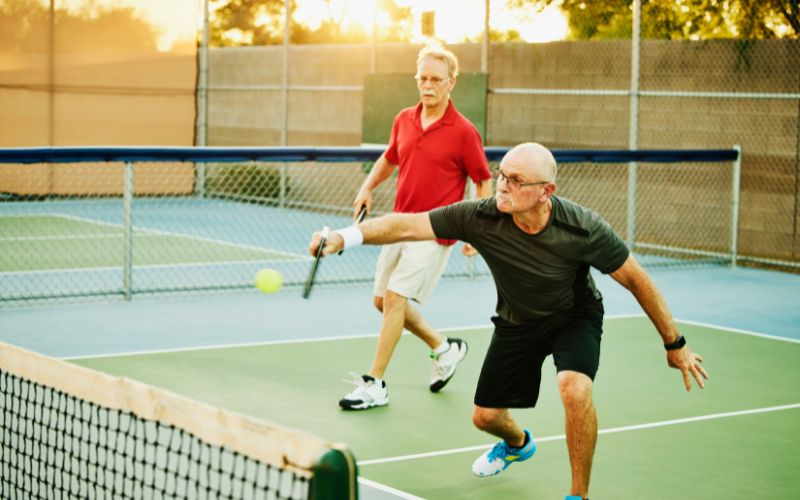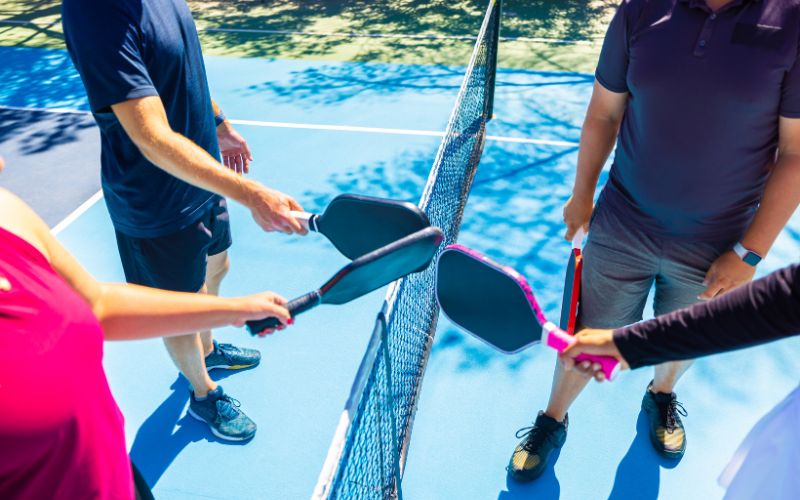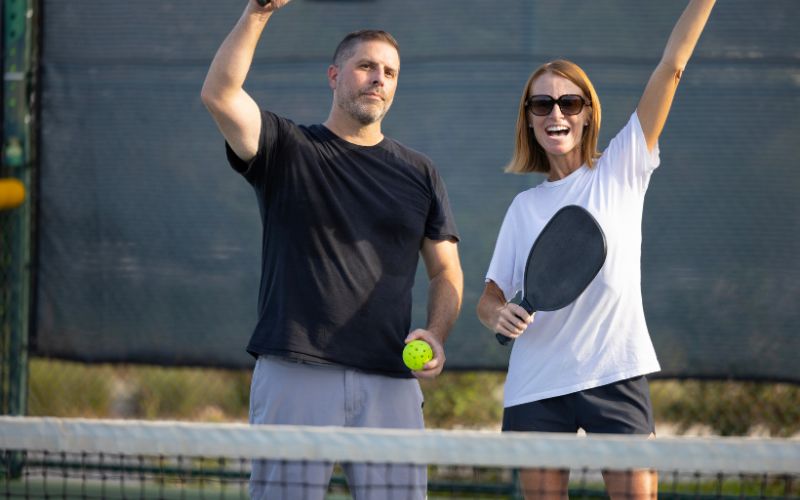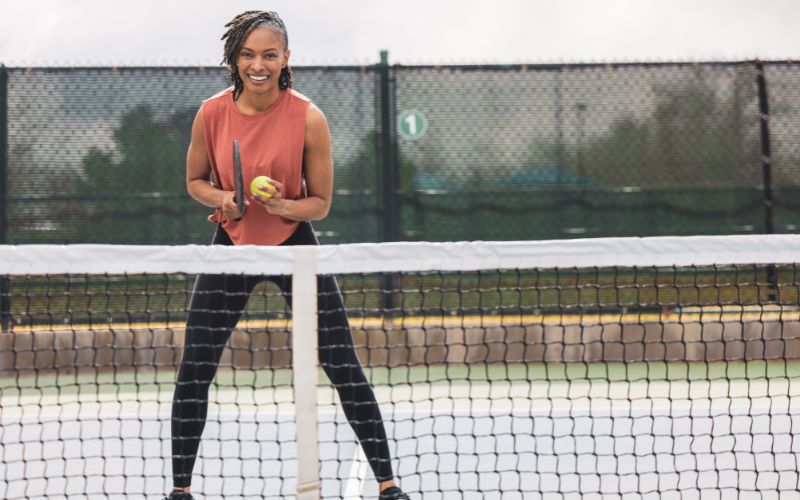Pickleball, a dynamic and rapidly growing sport, has become a favorite among players of all ages. But what sets the champions apart from the rest? The answer often lies in mastering the art of “stacking.” Stacking in Pickleball is a strategic maneuver in doubles play, where both team members begin on the same side of the court, is a game-changer, providing players with a competitive edge. Stacking is not merely about positioning; it’s about optimizing your court coverage, mobility, and control.
At its core, stacking hinges on the idea of leveraging each player’s strengths while compensating for their weaknesses. Initially positioning both players on one side of the court provides the flexibility to adapt to the game’s dynamics and exploit each player’s dominant hand or preferred playing style. This tactical maneuver introduces an element of adaptability and surprise, throwing opponents off their game.
In this comprehensive guide, we will delve into the world of stacking in pickleball. From understanding the fundamentals to excelling in its execution, whether you’re on the serving or receiving end, these insights are bound to elevate your pickleball game and set you on the path to victory. Let’s begin with the basics of stacking and explore the nuances of this fascinating strategy that can transform your play on the court.
What is Stacking in Pickleball?
Stacking in pickleball is a strategic maneuver employed in doubles play where both players on a team initially line up on the same side of the court, referred to as stacking, before a serve or return. This formation is used to optimize court coverage, mobility, and control.
The key idea behind stacking is to take advantage of the strengths of each player and compensate for their weaknesses. By initially positioning both players on one side of the court, they have the flexibility to shift to their preferred side after the ball is served or returned. This allows them to adapt to the game dynamics and exploit the strengths of each player, such as their dominant hand or preferred playing style.
In a stacked formation, one player typically stands closer to the center of the court, ready to move to the forehand or backhand side as needed. The other player is positioned nearer to the sideline, ready to cover the other side of the court. This arrangement offers a versatile and adaptable approach to the game, enhancing the team’s control and flexibility.
Stacking is a departure from the traditional positioning in pickleball, where players usually start with one player on each side of the court. By stacking, teams can strategically position themselves to gain an advantage based on their specific skills and game plan, making it a valuable tactic in competitive doubles pickleball play.
How to Stack on the Serve
Stacking as the Serving Team
Stacking in pickleball, as the serving team, is a strategic maneuver that allows you to optimize your court positioning. In traditional pickleball, players in doubles team must switch sides of the court after each point is scored, but stacking offers an exception to this rule. Here’s how stacking works for the serving team:
Start “Unstacked”: At the beginning of the game, you and your partner will typically begin “unstacked.” In other words, you will start in your “normal” positions, with the player starting on the right-hand side of the court standing on the right side, and the player starting on the left-hand side of the court standing on the left side.
After a Point: After a point is scored, the first server will move to the left-hand side of the court. To stack, the partner of the first server will stand to the left of the first server (rather than moving to the right-hand side of the court). This stacking configuration helps to optimize your positioning and strategy.
Serving and Positioning: Once the first server serves the pickleball, both players – the first server and their partner – will take a step to the right and return to their normal positions. This repositioning ensures that you are prepared for the subsequent play.
Second Server: Similarly, when the second server serves, if they must serve from the right-hand side of the court, their partner will stand to the right of the second server. After the second server serves, both players – the second server and their partner – will take a step to the left and return to their normal positions.
Consider the Score: Stacking is linked to the score. As a rule of thumb, if you started the game unstacked, you and your partner should only stack when you have an odd number of points (1, 3, 5, 7, 9, etc.). If you have an even number of points (0, 2, 4, 6, 8, 10, etc.), you and your partner should be unstacked and in your “normal” positions.
Ask the Referee: If you ever become uncertain about your positioning or the score, especially when there is a referee present, don’t hesitate to ask the referee for clarification. They can help ensure that you are in the correct position according to the score and the stacking strategy.
Stacking When Returning a Serve
Stacking as the receiving team in pickleball is a strategic technique that allows you and your partner to optimize your court positioning when receiving a serve. Here’s how stacking works for the receiving team:
Start “Unstacked”: Generally, at the beginning of the game, you and your partner will begin “unstacked” and in your “normal” positions, which means you are positioned as you would typically be on the court.
One Point Scored: If you and your partner have only one point, a rule exception comes into play. You and your partner will switch sides from your original starting positions to the opposite sides. For instance, if your partner is the first server, you will switch sides with your partner and prepare to take the return of serve from the right-hand side of the court.
Returning the Serve: After switching sides and when it’s your turn to return the serve, you and your partner have the option to switch back to your preferred sides after hitting the return. This allows you to play the remainder of the rally from your usual positions, optimizing your court coverage.
To accomplish this, as the receiving team, you have two options for stacking:
Traditional Stacking: In this option, you will receive the serve as usual, and your partner will stand at the Non-Volley Zone line just out-of-bounds to the right of the pickleball court. After striking your return of serve, both you and your partner will shift on the court to the left. This means you will have to cross the court from the right-hand side baseline to the left-hand side Kitchen line. The benefit of this option is that you and your partner have visibility of the entire court throughout the rally, but it can also make your strategy more predictable to your opponents.
Switching: In the second option, you will receive the serve as normal, and your partner will stand at the Non-Volley Zone line on the left-hand side of the pickleball court, which is also a typical starting position. After your return of serve, you and your partner will switch sides. Your partner will move towards the middle of the pickleball court. This approach has the following advantages: it keeps the middle of the court generally covered, keeps your opponents guessing about your strategy, and allows you to abort the stack/switch if your opponents deliver a strong serve that makes it too difficult to recover and switch sides.
The downside of the switching approach compared to traditional play is that it involves a moment when the receiving player is blinded on the court by their partner, which can lead to increased errors. Additionally, this method requires extra partner communication, typically through hand signals, to ensure both partners are on the same page with the game plan, which can sometimes lead to miscommunication.
As with stacking for the serving team, it’s important to pay attention to the score when stacking as the receiving team. In general, if you started the game unstacked, you and your partner should only stack when you have an odd number of points (1, 3, 5, 7, 9, etc.). If you have an even number of points (0, 2, 4, 6, 8, 10, etc.), you and your partner should be unstacked and in your “normal” positions.
Strategies for Excelling in Stacking within the Game of Pickleball
Mastering stacking in pickleball can provide you with a significant advantage on the court, allowing you to strategically control which side you and your partner play on. Whether you’re the serving team or receiving team, here are some tips to help you become proficient at stacking in pickleball:
Switching and Faking:
- To keep your opponents guessing and add an element of surprise to your strategy, consider switching and occasionally faking the switch. Use hand signals to communicate with your partner before the serve. For instance, use a fist to signal your partner to stay in the normal positions and use an open hand to indicate a switch. Verbally confirm your hand signals with your partner to avoid miscommunication.
- Know Where and How to Hit Your Return of Serve:
- Pay attention to your return or serve as it can significantly impact the success of your stacking strategy.
- Avoid rushing your return of serve. Take your time to hit a quality return before moving to your next location. Rushing can lead to unforced errors.
- Return the serve deep into the court to keep your opponents at bay and provide you and your partner with more time to complete the side switch.
- Use a slower pace and add a little more arc to your return. This provides additional time for you and your partner to get in position because the serving team must let your return or serve bounce before the third shot.
- Consider returning the ball down the line (away from the side where the receiver is switching). This creates more distance between the serving team and the player on the move and limits your opponents’ angles of attack.
- Target the Weaker Opponent:
- If one opponent has a weaker drive than the other, focus your returns of serve on the weaker player. Strong drives can exploit the vulnerabilities of a stacking team, so it’s strategic to direct your returns to the less proficient player, making it more challenging for your opponents to attack effectively.
- Half Stack or Three-Quarters Stack:
- Given the complexity of stacking, some teams opt for variations of stacking, such as the “half stack” or “three-quarters stack.” In the half stack, you only stack when serving, and in the three-quarters stack, you stack when serving and when the faster player is the receiver. The latter approach is usually avoided when the slower player is at the baseline due to the large distance they have to cover.
- The flexibility to stack only in specific circumstances or to abort the stack is a valuable option. However, this approach requires excellent communication and chemistry with your partner to make quick decisions during the game.
Mastering the art of stacking in pickleball is a game-changing skill that provides a competitive advantage, whether you’re serving or receiving. Stacking allows for strategic positioning and adaptability, keeping opponents guessing with the option to switch sides or fake the switch, provided you maintain effective communication with your partner.
Furthermore, your return of serve is pivotal; taking your time, hitting deep, employing arc, and targeting the weaker opponent can disrupt your opponents’ plans and increase your chances of success.
Consider variations like the half stack or three-quarters stack for added flexibility, enabling you to adapt to specific game situations. In competitive pickleball, mastering stacking can be the key to outmaneuvering opponents, adjusting to changing dynamics, and securing more victories. Whether you’re a novice or an experienced player, these stacking tips can elevate your pickleball game to the next level.
Frequently Asked Questions:
What is stacking in pickleball?
Stacking in pickleball is a strategic tactic used in doubles play where both players on a team start on the same side of the court before a serve or return. This initial positioning is employed to optimize court coverage, mobility, and control.
When should you use stacking in pickleball?
Stacking is typically used in doubles play to adapt to the strengths and weaknesses of the players on your team. It allows you to switch to your preferred sides after the ball is served or returned, making it a valuable tactic in competitive doubles pickleball. The decision to stack should be based on the score and the specific strategy of your team.
How does stacking work for the serving team in pickleball?
Stacking as the serving team involves starting unstacked, with each player in their normal position. After a point is scored, the first server moves to the left side, and their partner positions to their left. The serving and positioning continue according to the server’s side of the court. Stacking is primarily based on the score, typically done with an odd number of points.
What are the two options for stacking when receiving a serve in pickleball?
When receiving a serve, there are two stacking options. The first is traditional stacking, where one player stands off the court, and after returning, both players shift to their preferred sides. The second option is switching, where both players switch sides in the middle of the court after returning. The choice depends on your strategy, adaptability, and communication with your partner.
How can I excel at stacking in pickleball?
To excel at stacking, consider switching and faking the switch to keep opponents guessing. Focus on your return serve by avoiding rushing, returning deep, and adding arc to your shots. Target the weaker opponent to disrupt their game plan. You can also explore variations like the half stack or three-quarters stack for added flexibility in specific game situations. Effective communication with your partner is crucial for successful stacking.






